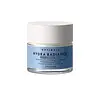What's inside
What's inside
 Key Ingredients
Key Ingredients

 Benefits
Benefits

 Concerns
Concerns

 Ingredients Side-by-side
Ingredients Side-by-side

Water
Skin ConditioningGlycerin
HumectantCaprylic/Capric Triglyceride
MaskingCetearyl Alcohol
EmollientCetyl Alcohol
EmollientDimethicone
EmollientPhenoxyethanol
PreservativePolysorbate 20
EmulsifyingCeteareth-20
CleansingBehentrimonium Methosulfate
Polyglyceryl-3 Diisostearate
EmulsifyingSodium Lauroyl Lactylate
EmulsifyingEthylhexylglycerin
Skin ConditioningPotassium Phosphate
BufferingDisodium EDTA
Dipotassium Phosphate
BufferingCeramide NP
Skin ConditioningCeramide AP
Skin ConditioningPhytosphingosine
Skin ConditioningCholesterol
EmollientXanthan Gum
EmulsifyingCarbomer
Emulsion StabilisingSodium Hyaluronate
HumectantTocopherol
AntioxidantCeramide EOP
Skin ConditioningWater, Glycerin, Caprylic/Capric Triglyceride, Cetearyl Alcohol, Cetyl Alcohol, Dimethicone, Phenoxyethanol, Polysorbate 20, Ceteareth-20, Behentrimonium Methosulfate, Polyglyceryl-3 Diisostearate, Sodium Lauroyl Lactylate, Ethylhexylglycerin, Potassium Phosphate, Disodium EDTA, Dipotassium Phosphate, Ceramide NP, Ceramide AP, Phytosphingosine, Cholesterol, Xanthan Gum, Carbomer, Sodium Hyaluronate, Tocopherol, Ceramide EOP
Water
Skin ConditioningGlycerin
HumectantHydrogenated Polydecene
EmollientAluminum Starch Octenylsuccinate
AbsorbentBetaine
HumectantTriethylhexanoin
MaskingCyclopentasiloxane
EmollientCyclohexasiloxane
EmollientButyrospermum Parkii Butter
Skin ConditioningCetyl Alcohol
EmollientGlyceryl Stearate
EmollientPEG-100 Stearate
Stearyl Alcohol
EmollientPhenoxyethanol
PreservativeAmmonium Acryloyldimethyltaurate/Vp Copolymer
Imidazolidinyl Urea
PreservativeCaprylyl Glycol
EmollientStearic Acid
CleansingPalmitic Acid
EmollientXanthan Gum
EmulsifyingNiacinamide
SmoothingSodium Starch Octenylsuccinate
AbsorbentCalcium Pantothenate
Maltodextrin
AbsorbentBiosaccharide Gum-4
Skin ConditioningCalluna Vulgaris Flower Extract
Skin ConditioningCastanea Sativa Seed Extract
Skin ConditioningSodium Ascorbyl Phosphate
AntioxidantArachidic Acid
CleansingLauric Acid
CleansingMyristic Acid
CleansingPyridoxine Hcl
Skin ConditioningTocopheryl Acetate
AntioxidantPotassium Sorbate
PreservativeSodium Benzoate
MaskingSilica
AbrasiveWater, Glycerin, Hydrogenated Polydecene, Aluminum Starch Octenylsuccinate, Betaine, Triethylhexanoin, Cyclopentasiloxane, Cyclohexasiloxane, Butyrospermum Parkii Butter, Cetyl Alcohol, Glyceryl Stearate, PEG-100 Stearate, Stearyl Alcohol, Phenoxyethanol, Ammonium Acryloyldimethyltaurate/Vp Copolymer, Imidazolidinyl Urea, Caprylyl Glycol, Stearic Acid, Palmitic Acid, Xanthan Gum, Niacinamide, Sodium Starch Octenylsuccinate, Calcium Pantothenate, Maltodextrin, Biosaccharide Gum-4, Calluna Vulgaris Flower Extract, Castanea Sativa Seed Extract, Sodium Ascorbyl Phosphate, Arachidic Acid, Lauric Acid, Myristic Acid, Pyridoxine Hcl, Tocopheryl Acetate, Potassium Sorbate, Sodium Benzoate, Silica
 Reviews
Reviews

Ingredients Explained
These ingredients are found in both products.
Ingredients higher up in an ingredient list are typically present in a larger amount.
Cetyl Alcohol is a fatty alcohol. Fatty Alcohols are most often used as an emollient or to thicken a product.
Its main roles are:
Though it has "alcohol" in the name, it is not related to denatured alcohol or ethyl alcohol.
The FDA allows products labeled "alcohol-free" to have fatty alcohols.
Learn more about Cetyl AlcoholGlycerin is already naturally found in your skin. It helps moisturize and protect your skin.
A study from 2016 found glycerin to be more effective as a humectant than AHAs and hyaluronic acid.
As a humectant, it helps the skin stay hydrated by pulling moisture to your skin. The low molecular weight of glycerin allows it to pull moisture into the deeper layers of your skin.
Hydrated skin improves your skin barrier; Your skin barrier helps protect against irritants and bacteria.
Glycerin has also been found to have antimicrobial and antiviral properties. Due to these properties, glycerin is often used in wound and burn treatments.
In cosmetics, glycerin is usually derived from plants such as soybean or palm. However, it can also be sourced from animals, such as tallow or animal fat.
This ingredient is organic, colorless, odorless, and non-toxic.
Glycerin is the name for this ingredient in American English. British English uses Glycerol/Glycerine.
Learn more about GlycerinPhenoxyethanol is a preservative that has germicide, antimicrobial, and aromatic properties. Studies show that phenoxyethanol can prevent microbial growth. By itself, it has a scent that is similar to that of a rose.
It's often used in formulations along with Caprylyl Glycol to preserve the shelf life of products.
Water. It's the most common cosmetic ingredient of all. You'll usually see it at the top of ingredient lists, meaning that it makes up the largest part of the product.
So why is it so popular? Water most often acts as a solvent - this means that it helps dissolve other ingredients into the formulation.
You'll also recognize water as that liquid we all need to stay alive. If you see this, drink a glass of water. Stay hydrated!
Learn more about WaterXanthan gum is used as a stabilizer and thickener within cosmetic products. It helps give products a sticky, thick feeling - preventing them from being too runny.
On the technical side of things, xanthan gum is a polysaccharide - a combination consisting of multiple sugar molecules bonded together.
Xanthan gum is a pretty common and great ingredient. It is a natural, non-toxic, non-irritating ingredient that is also commonly used in food products.
Learn more about Xanthan Gum